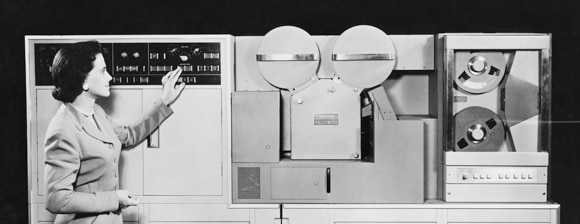
Technology moves at a rapid pace and looking back at reviews from many years ago may seem like a crazy idea. However, we dug up some pretty ancient copies of BYTE Magazine to take a look at what reviewers thought about new computers and other pieces of tech some 20, 30, or even more years ago.
By no means do we mean to pick at or make fun of these pieces of tech or the writers of the articles, but we also can’t help finding them very funny.
The RGS 008A Microcomputer Kit – 1975
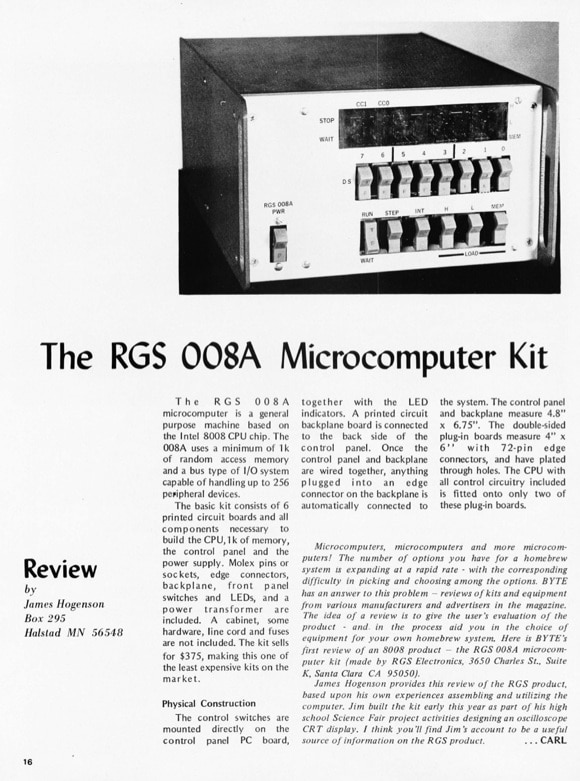
It was a time when, if you wanted your own computer, you had to build it yourself. In the pages of the very first BYTE Magazine from 1975, we can read about the RGS 0008A Microcomputer kit:
The basic kit consists of 6 printed circuit boards and all components necessary to build the CPI, 1K of memory, the control panel and the power supply. Molex pins or sockets, edge connectors, backplane, front panel switches and LEDs, and a power transformer are included. A cabinet, some hardware, line cord and fuses are not included. The kit sells for $375, making this one of the least expensive kits on the market.
Sure, $375 may not seem like a lot of money (it’s just over $1,600 today, adjusted for inflation), but keep in mind that you had to put it all together yourself. Do you even know what a “molex pin” is?
Imagine what an unboxing video could have looked like!
The PET 2001 – 1978
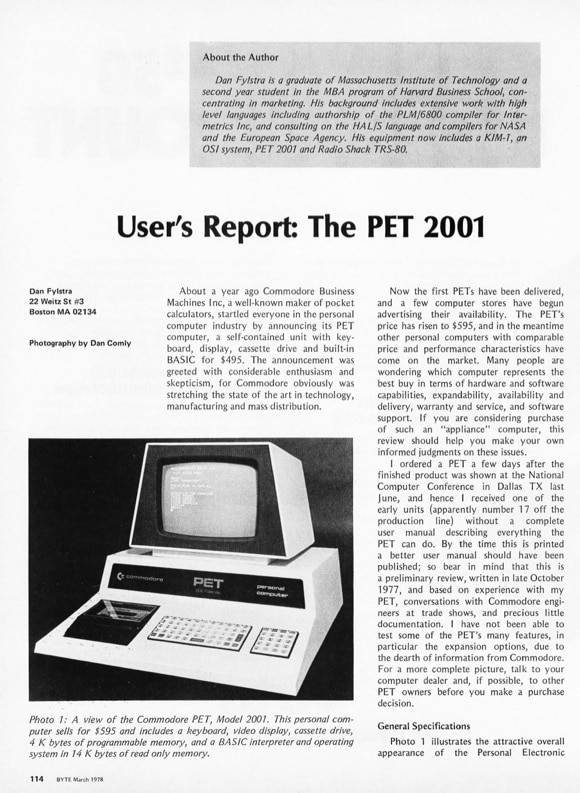
A highlight, according to Dan Fylstra, of the Commodore PET 2001 was that it came with a built-in cassette drive for storing programs and data. He wasn’t as enamored with the keyboard, however.
A much criticized feature of the PET is the design of the keyboard itself. It is a calculator style keyboard rather than a true typewriter keyboard. The keys are small and flat (about a half inch square and a quarter inch deep). They are tightly packed next to each other and are arranged in vertical rows rather than the slanting rows used on a typewriter keyboard. Although the alphabet follows the usual typewriter layout, the PET keyboard really cannot be used for touch typing because of the size, depth and spacing of the keys. The keyboard is said to be reliable and long lasting, but I did find that the space bar would not register correctly unless it was pressed squarely in the middle.
Cannot be used for touch typing? That certainly wouldn’t be good even today. Obviously we still struggle with many of the same issues today as the folks doing these early tech reviews.
HP-85 – 1980
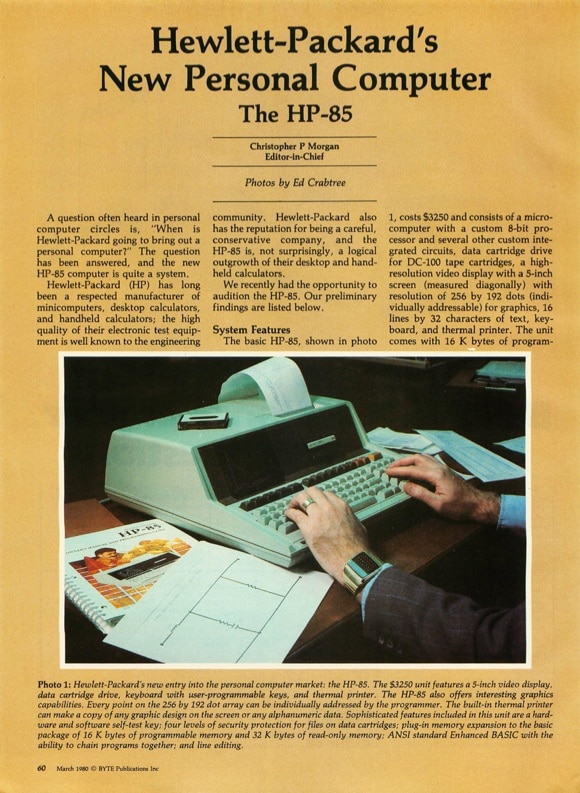
Before the IBM PC was introduced, Hewlett-Packard launched its own personal computer, the HP-85.
Hewlett-Packard’s new entry into the personal computer market: the HP-85. The $3250 unit features a 5-inch video display, data cartridge drive, keyboard, with user-programmable keys, and thermal printer. The HP-85 also offers interesting graphics capabilities. Every point on the 256 by 192 dot array can be individually addressed by the programmer. The built-in thermal printer can make a copy of any graphic design on the screen or any alphanumeric data. Sophisticated features included in this unit are a hard- ware and software self-test key;four levels of security protection for files on data cartridges; plug-in memory expansion to the basic package of 16 K bytes of programmable memory and 32 K bytes of read-only memory; ANSI standard Enhanced BASIC with the ability to chain programs together; and line editing.
What a package – 5-inch display, data cartridge drive, and a thermal printer!
The Sinclair Research ZX80 – 1981
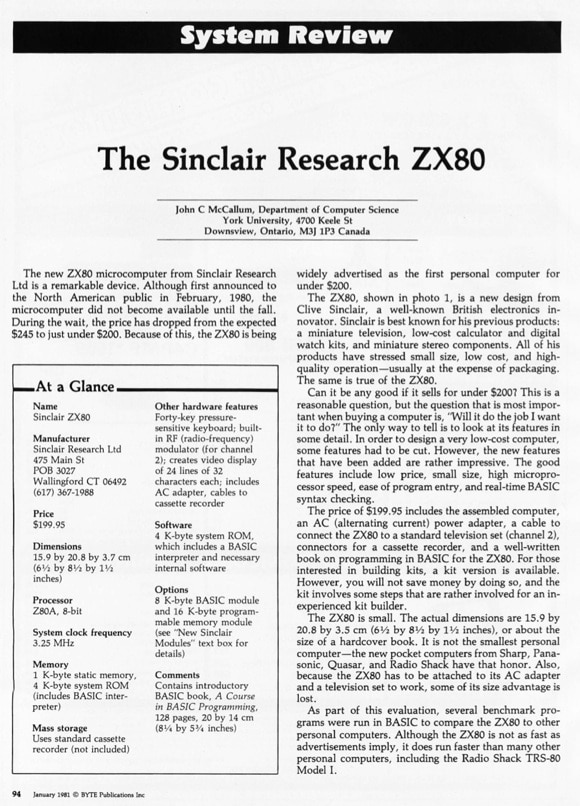
John McCallum discovered something very interesting about writing code in BASIC on the Sinclair ZX80:
ZX80 BASIC not only prevents you from making syntax errors, but it also prompts you with a cursor that tells you what it is expecting – a keyword (denoted by a K inside the square cursor) a literal (denoted by an L), or a numerical literal (denoted by an LS). When a program is expecting string input, it puts the cursor between the quotes, then expands the quotes as you enter text.
Embryo to autocomplete, perhaps?
Zork, The Great Underground Empire – 1981
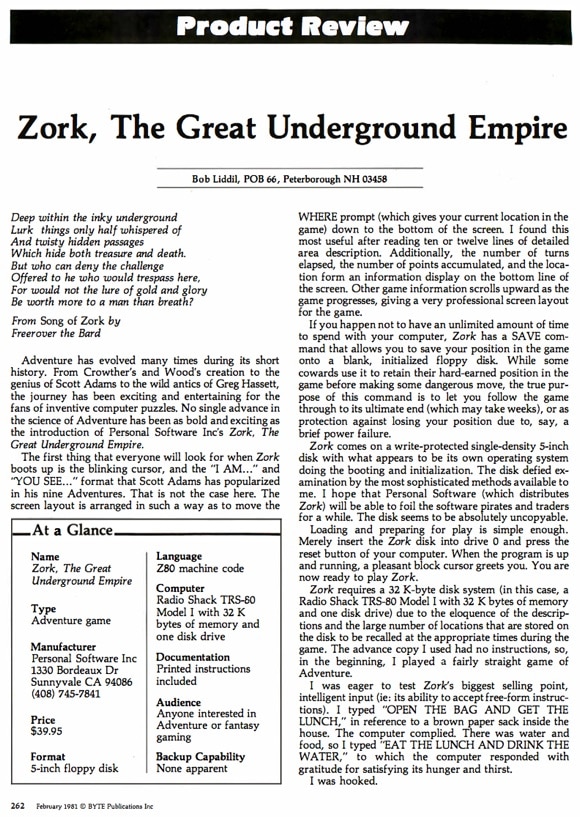
It wasn’t the original Zork that Bob Liddil reviewed, but that doesn’t seem to have diminished his enthusiasm any.
Zork requires a 32 K-byte disk system (in this case, a Radio Shack TRS-80 Model I with 32 K bytes of memory and one disk drive) due to the eloquence of the descriptions and the large number of locations that are stored on the disk to be recalled at the appropriate times during the game.
Where would a 32 kB game get you today?
I was eager to test Zork’s biggest selling point, intelligent input (ie : its ability to accept free-form instructions). I typed “OPEN THE BAG AND GET THE LUNCH,” in reference to a brown paper sack inside the house. The computer complied. There was water and food, so I typed “EAT THE LUNCH AND DRINK THE WATER,” to which the computer responded with gratitude for satisfying its hunger and thirst.
Absolutely amazing, don’t you think? Putting sarkasm aside for a minute, for the time it probably was absolutely amazing.
The MicroAce Computer – 1981
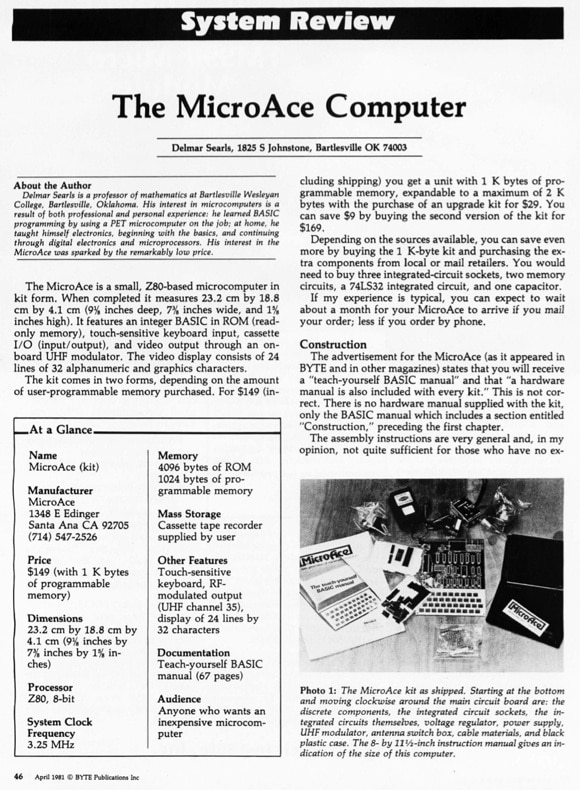
Mathematics professor Delmar Searls tackled the MicroAce computer in 1981. He didn’t have much luck in getting tape recorders to work with the computer.
I had to try two tape recorders before I could successfully load a program from tape. The first recorder I tried lacked a tone control and could not load a program, regardless of the volume setting. The second recorder had a tone control and loaded properly with the control set at maximum treble. The proper volume level seems to vary from tape to tape, even when they are made by the same company. Before saving a program, the program name is recorded on the tape by voice. A cable is attached between the microphone output of the computer and the microphone input of the recorder. The recorder is placed in its record mode and the SAVE command is entered followed by NEWLINE. The television screen goes blank for about five seconds, followed by a jumpy display of horizontal white lines. This indicates that the data is being output to the recorder. When the display returns to normal, the save is complete.
Much of that is standard fare for the time but what caught our attention was that you apparently had to record yourself saying the name of a program that you wanted to save.
IBM PC 5150 – 1981
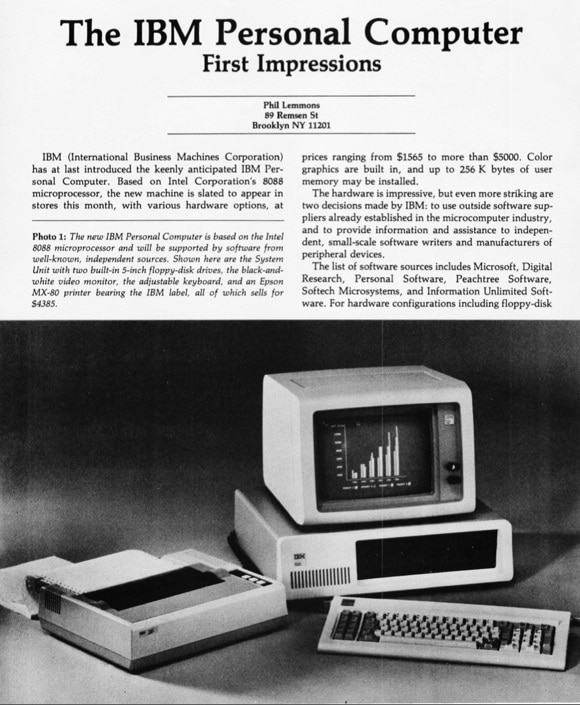
This was the first Personal Computer from IBM, which changed so many things. It may be even more significant for getting Microsoft off to such a great start with its DOS.
This CP/M look-alike from Microsoft offers the familiar ‘A>’ prompt character along with features for copying files and disks, comparing files and disks, initializing disks, displaying a directory, renaming files, and other housekeeping chores.
The Osborne 1 – 1982
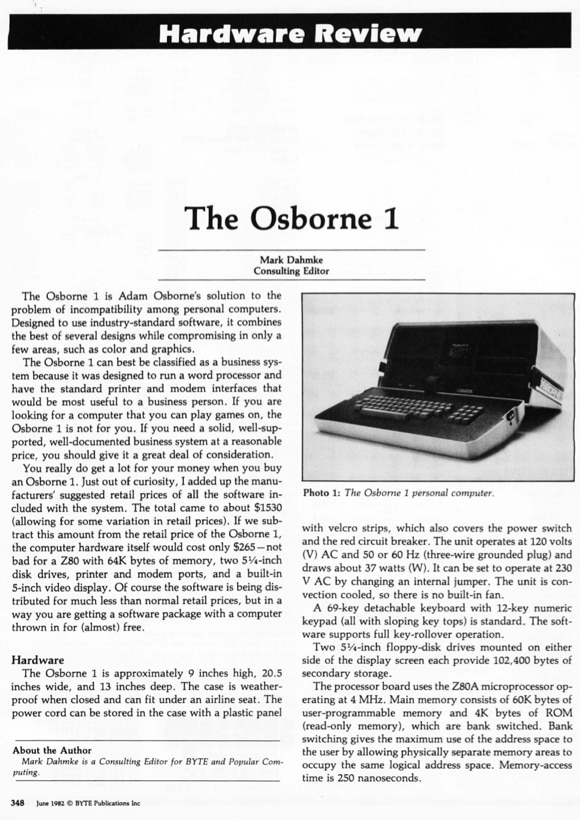
Although it was labeled as a portable, as reviewer Mark Dahmke found out, it was questionable whether the Osborne 1 deserved such a classification.
A recent ad for the Osborne 1 shows a man carrying a briefcase and another carrying an Osborne 1. While I can see many reasons for carrying along a computer in my work, I doubt I would carry an Osborne 1 in the same way I would carry a briefcase. First, the Osborne 1 weighs about 24 pounds, which would tire out all but the most athletic of travelers. Second, though the Osborne 1 was designed to fit under an airline seat, I don’t think I would want to put one there.
Microsoft Windows – 1983

Phil Lemmons wrote a preview of the upcoming Microsoft Windows 1.0 in 1983. Today, lots of people are busy previewing Windows 8 to be launched later this year. It’s worth noting that Windows then ran off two 320 kB floppy disks and 192 kB RAM.
Microsoft Windows seems to offer remarkable openness, reconfigurability, and transportability as well as modest hardware requirements and pricing. As a result, the desktop metaphor and mouse, intended to bring computing power to nontechnical people, are finally going to reach the hands of many such people. Barring a surprise product introduction from another company, Microsoft Windows will be the first large-scale test of the desktop metaphor in the hands of its intended users.
When reading the previews of Windows 8, we’re pretty sure you will still see mentions of the “desktop metaphor and mouse.” But the discussion now will be about how Windows 8 takes users from that paradigm into one dominated by touch.
The first Mac – 1984

In his review of the very first Mac in 1984, Bruce Webster called the it a “gem.” He wrote that the Mac was “rough, slightly flawed, but a gem nonetheless.” His complaints center on performance, writing that “the 128K-byte Macintosh with one single-sided drive is not a powerful machine.”
But what he wrote about the display echoes even more true today, with talk about Retina Display, full HD display on smartphone, etc.
The display is small (9-inch diagonal), but it has very high resolution (512 by 342 pixels). Every pixel is crisp. Several things make the display unusual. First, the Macintosh has no “text mode.” Instead, the display is always bit-mapped graphics. Second, the display is black-on-white rather than amber-, green- or color-on-black, giving it an ink-on-paper effect. Third, the pixels are equally dense both horizontally and vertically, eliminating the “aspect ratio” problem that plagues other graphic systems. (In other words, a box 20 pixels wide and 20 pixels high will be a square.) The effect is excellent. The display is clear, crisp, easy to read, and easy on the eyes. Because all text is graphically generated, the “what you see is what you get” word processing is available (with multiple fonts, sizes, and styles). Embedded drawings and proportional spacing are also possible. Some criticism has been made about the lack of a color-graphics capability. Frankly, I am unconvinced of its necessity. Most applications I have seen use color graphics as a substitute for detail, and the Mac can give you lots of detail.
Atari 1024ST – 1986
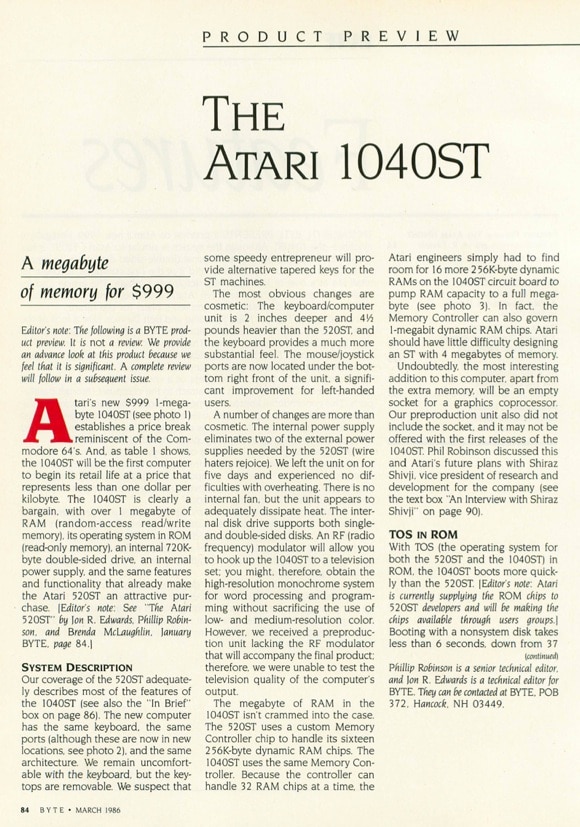
Finally we’ll look at a preview rather than a review, covering the Atari 1024ST in 1986. Right off the bat, Philip Robinson is clearly smitten with the 1024ST.
Atari’s new $999 1-megabyte 1040ST… establishes a price break reminiscent of the Commodore 64’s. And… the 1040ST will be the first computer to begin its retail life at a price that represents less than one dollar per kilobyte. The 1040ST is clearly a bargain, with over 1 megabyte of RAM (random-access read/write memory), its operating system in ROM (read-only memory), an internal 720K- byte double-sided drive, an internal power supply, and the same features and functionality that already make the Atari 520ST an attractive purchase.
What’s your favorite tech review of all times?
If you spotted that we actually included 11 reviews, then a small gold star to you. We were just having too much fun going through these all tech magazines that we completely lost count.
But this was just a small sample of the vintage tech reviews we could find, each with a funny story to tell, especially in light of how fast technology develops. And in some cases, also, what doesn’t change too much over the years.
Do you have a particular tech review, be it of a computer, software, game, or something else, which you treasure for a particular reason?
Share it with us in the comments below.
Image (top) via Shutterstock. Quotes and pictures from BYTE Magazine from here.


























